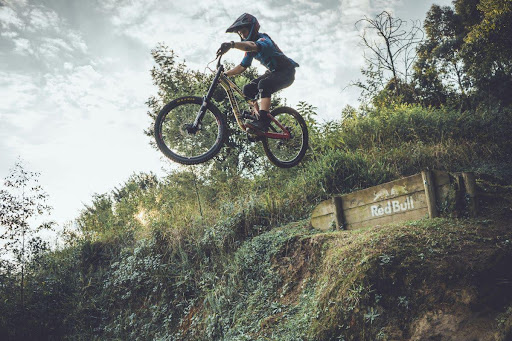Exploring the mountains offers a unique blend of exhilaration and tranquility, where the rugged landscapes serve as an ideal backdrop for a diverse range of sports. Whether you’re seeking an adrenaline rush or looking to build endurance and skill, mountainous terrains provide the perfect setting for pushing your limits. This article delves into the best sports to practice in the mountains, each offering its own set of challenges and rewards.
Key Takeaways
- Mountain sports such as big mountain snowboarding and monoskiing offer experiences in unpredictable environments, perfect for those seeking adventure.
- Activities like cross-country skiing and mountain biking are not only fun but also excellent for maintaining and improving physical fitness, especially for cyclists during off-season.
- Sports like deep water soloing and dog sledding cater to a wide audience, providing unique experiences that combine the beauty of nature with physical challenges.
Mountain Sports for Adventure Seekers
Big Mountain Snowboarding: Embracing the Unpredictable
Big Mountain Snowboarding is a sport that takes snowboarding to the vast and untamed wilderness areas beyond resort boundaries. It’s about embracing the unpredictable nature of the mountain, where every descent is a unique experience shaped by the ever-changing conditions of the snow and terrain.
Safety is paramount in such an environment. Riders must be prepared for any situation, carrying essential gear for navigation and survival. A typical safety kit might include:
- Avalanche transceiver
- Shovel
- Probe
- First aid kit
Big Mountain Snowboarding is not just about the descent; it’s a journey that starts with meticulous planning and ends with the satisfaction of conquering nature’s most challenging slopes.
The sport attracts those who seek a pure connection with the mountain, where the only tracks are the ones they leave behind. It’s a test of one’s ability to read the terrain and make split-second decisions, a skill that is honed over time and with experience.
Mountain Boarding: Skateboarding Meets Snowboarding
Mountain boarding is an exhilarating sport that combines elements of skateboarding and snowboarding. It involves a snowboard-sized deck with wheels, allowing riders to navigate natural terrains like mountain slopes and woodlands. The sport is gaining traction among avid snowboarders and is now recognized at various ski resorts.
Mountain boarding requires balance, agility, and a sense of adventure. Here’s what newcomers should know:
- Safety gear is essential. Always wear a helmet, knee pads, and elbow pads.
- Start on gentle slopes to get a feel for the board’s movement.
- Practice makes perfect. Dedicate time to mastering turns and stops.
As the sport grows in popularity, more locations are opening up to mountain boarders. Resorts like Snowmass, Copper Mountain, Winter Park, Vail, and Keystone have welcomed the sport, reflecting its expanding community.
Monoskiing: The Unique Challenge of a Single Ski
Monoskiing offers a distinctive experience on the slopes, combining elements of skiing and snowboarding into one. With both feet strapped side-by-side on a single wide ski, the sport presents a unique set of challenges. Unlike traditional skiing, monoskiing requires a different balance and technique, making it an intriguing option for those looking to diversify their winter sports repertoire.
Monoskiing is not just about the descent; it’s a full-body workout that enhances your core strength and balance.
Monoskiing is a testament to the innovation in live sports, offering a fresh perspective on mountain activities.
While it may not be as widespread as other mountain sports, monoskiing has a dedicated community of enthusiasts. Here are a few reasons why it’s worth trying:
- It’s a conversation starter and a way to stand out on the slopes.
- The unique stance can offer a new challenge to seasoned skiers.
- It provides a different way to enjoy the mountain scenery.
Whether you’re a seasoned skier looking for a new challenge or a newcomer to live sports in the mountains, monoskiing is an adventure worth considering.
Motocross: High-Speed Off-Road Racing
Motocross is a form of off-road motorcycle racing that tests both the rider’s skill and the bike’s resilience. Competitions are held on natural or artificial tracks with a variety of surfaces, including mud, grass, and gravel. While motocross is a great live sport to watch, it’s also physically demanding and requires riders to maintain peak condition to avoid fatigue-related accidents.
For enthusiasts who can’t get enough of the adrenaline rush, following motocross events can be as engaging as participating. With the advent of online casino platforms, fans have the opportunity to engage with the sport in a new way, including sports betting on their favorite riders and teams.
Safety is paramount in motocross, and adhering to proper precautions is essential:
- Wear appropriate protective gear.
- Inspect your bike before each ride.
- Be mindful of the track conditions.
- Take breaks to rest and hydrate.
Motocross combines the excitement of high-speed racing with the unpredictability of rugged terrain, offering a unique challenge to those who dare to take it on.
Deep Water Soloing: Climbing Over Water Without Ropes
Deep Water Soloing (DWS) is a form of rock climbing that is performed without the use of ropes or harnesses. Instead, climbers rely on the presence of water at the base of the climb to cushion any falls. This sport combines the physicality of climbing with the mental challenge of overcoming fear, as the only safety net is the water below.
Climbers must possess strong swimming skills and be comfortable with heights to safely engage in DWS. The sport often takes place on sea cliffs, where the water can provide a dramatic and beautiful backdrop for the climb.
- Preparation is key: check weather conditions and water depth.
- Always climb with a partner for safety.
- Know your limits and climb within them to prevent accidents.
Deep Water Soloing offers a pure form of climbing, where athletes can push their boundaries in a unique environment.
The sport has seen a rise in popularity, with locations around the world becoming hotspots for enthusiasts seeking the thrill of climbing unencumbered by gear. As with any extreme sport, it is crucial to respect the environment and adhere to local regulations to ensure the preservation of these natural climbing venues.
Endurance and Skill-Building Mountain Activities
Mountaineering: The Art of Summiting Peaks
Mountaineering combines physical endurance, mental determination, and technical skill to conquer some of the world’s highest peaks. It is an endeavor that challenges the human spirit against the raw magnificence of nature.
Mountaineering expeditions vary greatly in difficulty and duration, often requiring a significant investment in time and resources. The preparation phase is crucial, encompassing physical training, route planning, and gear selection.
Safety is paramount in mountaineering. The use of IFMGA-certified guides ensures that climbers have expert leadership and knowledge, which is essential for a successful and safe ascent.
Here is a list of popular mountaineering expeditions:
- Mount Everest Expedition
- Aconcagua Climbing Guide
- Cho Oyu Climbing Guide
- The Seven Summits
- Rapid Ascent™ Expeditions
Each expedition offers a unique set of challenges and rewards, and selecting the right one depends on the climber’s experience, goals, and preparedness.
Mountain Biking: Conquering Rough Terrain
Mountain biking stands out as a sport that combines endurance with technical skill, offering a way to explore nature while challenging oneself on diverse terrains. It’s an activity that can be enjoyed at various levels of expertise, from beginners eager to improve their cornering techniques to advanced riders.
For those new to the sport, mastering cornering is essential for a safe and enjoyable experience. Here are some beginner tips:
- Look ahead and choose your line
- Lean the bike, not your body
- Control your speed before the turn
- Practice on different surfaces
Experienced riders often seek out trails that test their limits. The Goodwater Loop of Lake Georgetown, recognized as an IMBA EPIC by the MTB Project, is one such trail. It’s known for its skills building opportunities and scenic views, particularly near Serenada, Texas. This trail is not just about endurance; it also has a dedicated skills area off the top of Powerline trail.
Mountain biking is not just a sport, it’s a way to connect with the environment and push personal boundaries. Whether you’re navigating a tight switchback or powering up a steep incline, every ride is a new adventure.
Cross-Country Skiing: Keeping Cyclists in Shape Off-Season
Cross-country skiing offers a seamless transition for cyclists during the winter months. It keeps you in top cycling shape when the roads are less accessible for biking. This sport engages the leg and glute muscles essential for powerful pedaling, as well as the upper body and core, which are crucial for a strong back and comfortable riding posture.
In addition to maintaining muscle strength, cross-country skiing ensures that cyclists’ aerobic fitness doesn’t wane in the off-season. The rhythmic motion and endurance required for skiing mimic the sustained effort of cycling, making it an ideal cross-training sport.
Cross-country skiing not only complements cycling in terms of physical conditioning but also offers a refreshing change of scenery and a new set of challenges to conquer.
While it’s a fantastic way to stay fit, cross-country skiing also provides a full-body workout that can improve overall athleticism. Here are some benefits specific to cyclists:
- Works leg and glute muscles for pedaling strength
- Targets the upper body with ski pole usage
- Activates and strengthens the core
- Maintains aerobic fitness and bone density
By incorporating cross-country skiing into their training regimen, cyclists can enjoy the outdoors year-round and return to the saddle in spring with no loss in performance.
Dog Sledding: A Family-Friendly Adventure
Dog sledding offers a unique blend of excitement and family bonding, making it an ideal mountain activity for all ages. Gliding over snowy landscapes while being pulled by a team of enthusiastic dogs, eager to race through the frosty air. This sport not only provides an adrenaline rush but also allows participants to connect with nature and the incredible endurance of sled dogs.
- Preparation: Dress warmly in layers and receive a brief training on handling the sled.
- The Ride: Enjoy the picturesque views and the silent swiftness of the sled.
- Interaction: Spend time with the dogs and learn about their care and training.
Dog sledding is not just about the ride; it’s about the entire experience, from the moment you meet your sled team to the serene journey across the winter wonderland.
Fairbanks, in the heart of interior Alaska, is renowned for its dog sledding adventures. Here, families can mush through pristine forests and over frozen rivers, creating memories that will last a lifetime.
Fell Running: Off-Road Running Over Tough Terrain
Fell running, a sport deeply rooted in British tradition, involves off-road running over challenging landscapes. It’s a test of both endurance and navigation skills, as runners traverse steep hills, rocky paths, and often unpredictable weather conditions.
The allure of fell running lies in its simplicity and the natural obstacles it presents. No two runs are ever the same, with each route offering unique challenges that require quick thinking and adaptability.
Fell running is not just about physical fitness; it’s a mental game where strategy plays a crucial role in overcoming the elements and the terrain.
For those interested in starting fell running, here’s a basic checklist to consider:
- Appropriate footwear for grip and support
- Weather-appropriate clothing
- Hydration system
- Navigation tools (map and compass)
- Knowledge of the route
- Training for varied terrain
While the sport may seem daunting at first, the community is known for its welcoming nature, and local clubs often offer group runs and events for all levels of experience.
Conclusion
Exploring the mountains through sports offers a unique blend of adventure, physical challenge, and connection with nature. From the descents of big mountain snowboarding to the endurance test of cross-country skiing, each activity provides a distinct experience. Mountain boarding and monoskiing cater to those seeking innovation on traditional terrains, while mountaineering and motocross push the limits of exploration and skill. Whether you’re cycling through rugged trails or engaging in the serene practice of deep water soloing, the mountains are a playground for the adventurous spirit. As we’ve seen, these sports not only offer excitement but also keep athletes in peak condition throughout the year. So, gear up, respect the environment, and embrace the mountain sports that call to you, ensuring unforgettable experiences and stories to last a lifetime.
Frequently Asked Questions
How do I get started with big mountain snowboarding?
Begin by renting gear and exploring local trails with fresh powder. Dress in layers and go with an experienced snowboarder or watch online tutorials to learn basic techniques. Remember, it’s about having fun and getting the rhythm over time.
What are the benefits of cross-country skiing for cyclists?
Cross-country skiing maintains cycling shape during the off-season, targeting leg and glute muscles, as well as the upper body and core. This helps cyclists maintain strength for powerful pedaling and a comfortable ride position.
What is mountain boarding and how does it differ from snowboarding?
Mountain boarding involves riding a snowboard-sized deck with wheels over natural terrain like mountain slopes. It combines elements of skateboarding and snowboarding, differing from the latter by not requiring snow and offering a different terrain experience.





